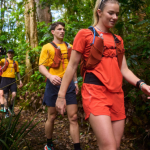Trail running presents unique challenges that road running simply can’t match. With uneven terrain, steep inclines, and dramatic elevation changes, you need more than just endurance; you need specific techniques to improve your efficiency and prevent injury. Whether you’re a seasoned runner or just starting out, mastering these skills will make your trail running more enjoyable and effective. Let’s break down the key elements of good trail running form and technique to help you tackle the trails with confidence.
Basics of Good Running Form
While every runner has their own unique style, there are several common traits that indicate good running form. These basic principles are crucial for improving your technique and ensuring that your body functions efficiently.
Proper Posture
Maintaining good posture is fundamental to running well. A slight forward lean from the ankles (not the waist) helps keep your body aligned and engages the right muscles, especially your glutes and hamstrings, for a more powerful stride. Avoid bending at the waist, as it can lead to slouching and back pain. If you have tight hip flexors, you may need to address this issue to improve your stride. Tightness in this area limits your range of motion, making it harder to run effectively.
Short Strides
Overstriding leads to heel strikes, which increase the impact on your joints and can cause repetitive stress injuries. Instead, focus on taking short, quick strides. This helps you land closer to your body’s center of gravity, promoting a smoother stride and reducing the strain on your joints. Shorter strides also allow for more flexibility when navigating obstacles, such as roots or rocks, making your run more efficient and controlled.
Cadence
To maintain a fast pace with shorter strides, you’ll need a higher cadence (the number of steps per minute). Most runners aim for a cadence around 180 steps per minute, but this varies based on your fitness and running style. If your cadence is below 170 steps per minute, try to gradually increase it. A faster cadence reduces the risk of injury by ensuring a smoother, more consistent foot strike.
Foot Strike: Forefoot, Midfoot, or Heel?
In trail running, your foot strike will vary depending on the terrain. Some runners prefer a midfoot strike, but it’s important to note that all three types—forefoot, midfoot, and heel strikes—have their place on different trail surfaces. Trail running involves changing foot strikes to adapt to gradients, obstacles, and terrain. While a midfoot strike is often recommended for its efficiency, especially on flat ground, heel strikes can still work for some runners, as long as they’re not creating high-impact stresses.
If you do decide to experiment with a midfoot strike, you may want to transition gradually and consider switching to zero-drop shoes for better alignment and comfort.
Efficient Movement Throughout the Body
Good form isn’t just about your legs—it’s about your entire body working together.
Look Ahead
Keep your eyes on the trail ahead to anticipate upcoming obstacles. This is essential for maintaining your balance and ensuring you place your feet correctly. Looking down at your feet can strain your neck and shoulders, leading to unnecessary tension. Keep your head up to stay relaxed and maintain good posture.
Use Your Arms for Balance
Your arms play an important role in maintaining balance and momentum. Keep your arms at a 90-degree angle or less and swing them in sync with your hips. On more technical trails, use your arms for extra stability, especially when navigating tricky sections. This will help you adjust your stride or change direction quickly.
Relax Between Strides
Tension in your muscles can waste energy and lead to early fatigue. Focus on relaxing your legs, arms, and shoulders during your stride recovery. The more relaxed you are between strides, the more energy you’ll save for the next stretch of the trail. This will help you keep your pace without feeling overly exhausted.
Uphill Technique
Running uphill can be a challenge, but with the right technique, you can become more efficient and even enjoy the climb.
Lean Forward
When running uphill, leaning forward slightly helps you maintain momentum and use your legs to their full potential. Aim for a lean of about 3 to 4 degrees, aligning your body with the slope of the hill. This will prevent you from leaning back and using your upper body too much, which can cause fatigue.
Shorten Your Strides
Take smaller, quicker steps uphill to prevent overloading your muscles and to conserve energy. Big strides can stress your quads and lead to lactic acid buildup. Keep your stride length short to maintain your pace and reduce muscle fatigue.
Relax and Power Hike
When the incline becomes too steep for running, switch to power hiking. Lean forward slightly and use your hands to push down on your thighs for extra lift. Alternating between running and fast hiking is an effective way to tackle uphill sections without overexerting yourself.
Downhill Technique
Downhill running requires a different set of skills to maintain control and avoid injury.
Short, High-Cadence Strides
When descending, it’s crucial to avoid overstriding. Take short, quick steps to prevent excessive impact on your joints and to maintain traction. Raising your knees between steps will help you stay in control and prevent tripping on uneven ground.
Stay Upright
It may feel natural to lean back while running downhill, but this can increase the risk of slipping and losing control. Instead, stay upright and focus on keeping your body centered over your toes to ensure better contact with the ground and to prevent falls.
Hop, Skip, and Jump
When faced with rocks or other obstacles, sometimes the best way to get over them is to jump. Hopping over obstacles can help maintain your momentum, but it requires good balance and coordination. Start by practicing small jumps over single obstacles and gradually work your way up to clearing larger sections of the trail.
Running with Poles
Trekking poles can be a great addition to your trail running gear, especially on long uphill sections. They allow you to use your upper body for support, reducing the load on your legs and helping you maintain a steady pace. If you decide to use poles, make sure to practice with them to build strength and familiarity with the motion.
Conclusion
The best way to improve your trail running technique is simply to get out there and practice. With time, you’ll develop a natural rhythm and the skills needed to tackle any terrain. If you’re looking for more tips and advice, there are plenty of resources available to help you refine your technique and take your trail running to the next level.





